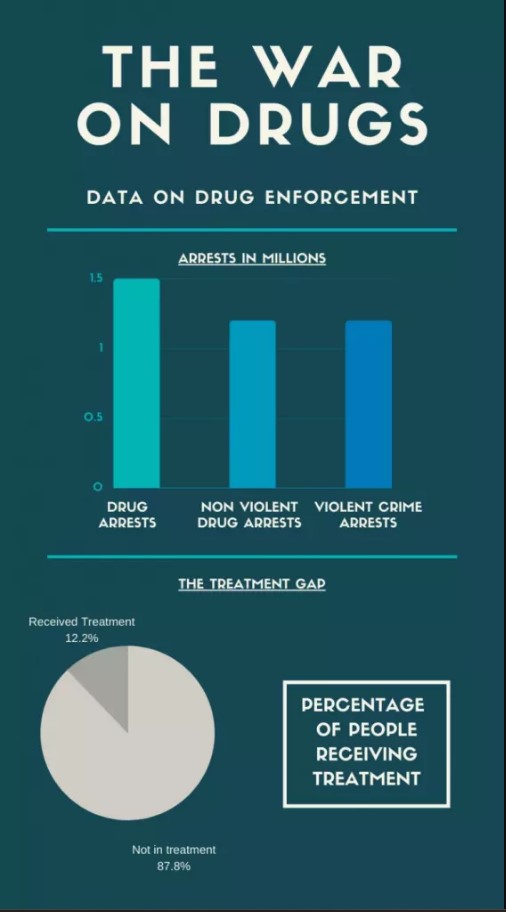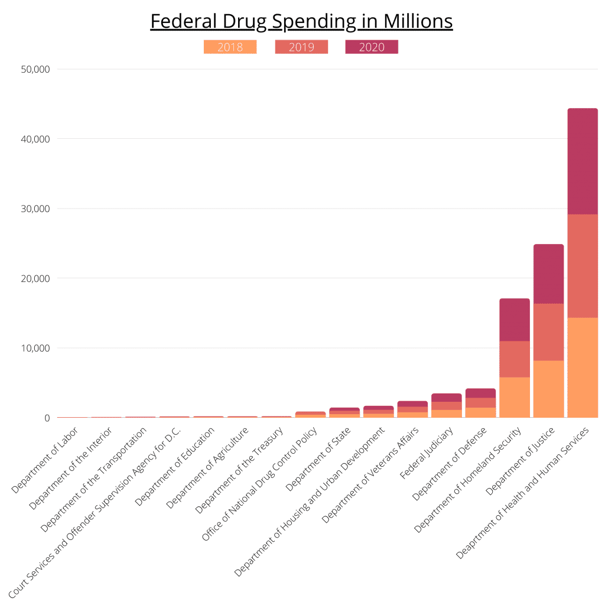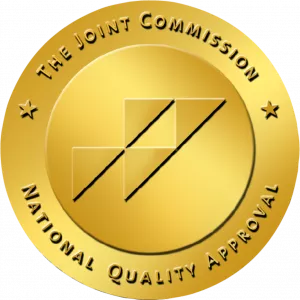I. Measure 110 in Oregon: Introduction
The War on Drugs

Image free for reuse with credit to avenuesrecovery.com
America, since the Nixon days, has been fighting what we have called the “War on Drugs.” It is a battle that has largely been fought through the criminal justice system. It has long been thought that the threat of imprisonment and legal consequences would discourage people from dealing with and using illegal substances. Every year, there are more than 1.5 million drug-related arrests in this country, more than the combined total arrests for all violent crimes combined. Over 80% of those drug arrests are for possession charges with no violent offenses attached.
Has Measure 110 in Oregon Worked?
The million-dollar question is if it has worked at all and if there is a more effective way to go about tackling a drug problem that doesn’t seem to be going away. Drug use continues to rise, seemingly unabated. Aside from the fact that the opioid epidemic is unsolved, the focus on charging every person who is carrying drugs for personal use has created a tremendous strain on the prison system and chews up tax dollars that could presumably go elsewhere, perhaps more effectively.
The Treatment Gap
There has long been talk of the “Treatment Gap” prevalent in the United States, which simply put, means that the difference between the number of people who need drug and alcohol abuse treatment and those who actually get it is an untold number of country miles. In 2017, SAMHSA pegged the number of Americans aged 12 and up who suffer from addiction at roughly 20 million. The number of people who have ever gotten treatment at a facility, you ask. A paltry 2.5 million. That represents 12.2 percent of the population who require it. Obviously, not nearly good enough.
There is more than one reason for this. Problems with insurance coverage, the denial that is rampant in addiction, and too many underserved areas with regard to the availability of quality treatment centers, are all making significant contributions to the Gap.
Is There a Solution?
Solutions to these issues inevitably involve money and resources. Can funding dedicated to punishing the minor players on the street be diverted to pushing those people to treatment rather than prison? Can there be programs and initiatives set up to create treatment pipelines and referrals coming by way of encouragement and outreach in place of drug courts and holding cells? Can the carrot work instead of the stick?
The people of Oregon have decided to find out.
What is Measure 110 in Oregon?
In November 2020, Oregon voters passed Measure 110, with over 58% percent of the vote. The initiative, funded by the Drug Policy Alliance, is a two-pronged approach to revamping conventional wisdom on how to beat the opioid epidemic. It boils down to this: stop arresting people for minor drug offenses and make treatment more widely available, regardless of a person’s financial or social status.
It is important to note that this new legislation does not abolish drug laws in Oregon or legalize drugs. It is merely a change to the consequences of possession violations. Repercussions for manufacturing, smuggling, and dealing remain the same.
The New Law’s Effects
The following highlights the specifics of how these goals are accomplished.
1. Reclassifying Drug Offenses
Many possession charges were previously Class A misdemeanors and can result in up to a year in prison and/or thousands of dollars in fines. Oregon decriminalized hard drugs, changing those crimes to Class E which comes with a hundred-dollar penalty and a mandate to complete a health assessment. Other more serious infractions, such as manufacture, or delivery of illegal drugs would still be treated as a felony.
Below is a chart from Ballotpedia detailing those changes.
|
Drug Schedules |
Charge prior to the election |
Existing maximum penalty |
Charge proposed by the initiative |
Proposed maximum penalty |
|
Schedule I |
Class A misdemeanor |
One year in jail and $6,250 fine |
Class E violation |
$100 fine or completed health assessment |
|
Schedule II |
Class A misdemeanor |
One year in jail and $6,250 fine |
Class E violation |
$100 fine or completed health assessment |
|
Schedule III |
Class A misdemeanor |
One year in jail and $6,250 fine |
Class E violation |
$100 fine or completed health assessment |
|
Schedule IV |
Class C misdemeanor |
30 days in jail and $1,250 fine |
Class E violation |
$100 fine or completed health assessment |
2. Create a network of state-funded treatment facilities
Oregonian Measure 110 mandated the establishment of a temporary telephone addiction recovery center, operating 24/7 and 365 days a year. This gave the state a year to establish physical addiction treatment locations by October 1st, 2021. According to the law, treatment facilities must offer immediate treatment including medical 24 hours a day, full health assessments by certified addiction treatment professionals, intervention and case management plans for each client, and peer support and outreach. These facilities must be covered by the Medicaid networks in the state, otherwise known as coordinated care organization service areas.
Facilities are funded by the Drug Treatment and Recovery Services Fund, which draws from Oregon marijuana tax revenue and the savings generated by the reduction of drug-related arrests due to the new legislation.
3. Oversight and Accountability Council
This committee oversees the fund grants ensuring that all monies are distributed properly. The law sets forth how this council will be staffed in great detail.

III. Is Drug Decriminalization a Good Idea: The Conversation
The Case Against Decriminalization:
However, many felt that although a facelift to drug war strategies is warranted, completely dismissing the fear of consequences for drug possession will do more harm than good. Many referrals to drug detox treatment and attendance enforcement camevia drug courts. Without that, an obligation to take part in addiction rehab will be downgraded from obligation to recommendation. Experts against decriminalization also argued that Oregon's decriminalization results in erasing any sort of punitive response to minor drug offenses, which can potentially lead to increased experimentation with illicit substances. This can lead to increased activity by drug manufacturers, traffickers, and dealers, to target people who would have otherwise been afraid to try drugs.
Those on that side of the fence mostly agreed that treatment isn’t easy enough to access and too often is financially prohibitive. They would rather attack that problem directly and initiate efforts to improve the addiction treatment infrastructure, without the sweeping measures called for by taking the justice system completely out of the picture.
The Case For Decriminalization:
Supporters of Measure 110 Oregon point to the sobering effects on prison systems due to minor drug arrests. It is no secret that many prisons are overcrowded, and quite frankly, dangerous. The stories are there for all of us to read. Furthermore, the lack of flexibility in sentencing measures has created too many instances of people who languish in jails for years on end, grossly disproportionate to the crimes they committed, robbing them of a chance to rebuild their lives and become productive members of society.
The Racial Disparity
There is a racial piece here as well. The disparity of African American incarceration directly linked to drug crimes is, quite frankly, depressing. It creates a ripple effect on Black communities and harms family units so crucial to healthy environments.
Legal Obstacles
Legal entanglement is an obstacle to recovery. People get stuck in a vicious cycle, from the back of police cars to in front of a judge to behind bars. Rinse and repeat. It is not an atmosphere that encourages people to believe in themselves and commit to the hard work of true recovery.
With money diverted from endless arrests and prison sentences to training empathetic professionals and building treatment facilities committed to creating lasting positive outcomes, proponents of Oregon Measure 110 are confident that real progress in the drug wars can be made.
IV. What happened in Portugal: A Case Study
What Oregon is doing has been tried before. In 2001, Portugal decriminalized drug possession. There are now close to 20 years of data available to analyze the effectiveness of this approach.
The Numbers and What They Mean
At first glance, the numbers look great. The drug-induced death rate in Portugal is five times lower than the EU average. The prison population tied to drug offenses has tumbled. There was a 60 percent increase in people in drug treatment from 1998 to 2011. HIV infections have completely crashed. At its peak, there were 104.2 cases per million. Portugal is now at 4.2 cases per million. These stats all support the idea that Portugal may have uncovered something in how drug laws should be written and enforced.
Another Opinion:
However, some argue that it is not so cut and dried. In reality, the major change in Portugal’s drug policy is overstated. Long before decriminalization was implemented, enforcement of the previous laws was quite loose. The change in 1999 was really in how the drug laws were written. Enforcement had largely been ignored since the early 90’s. It went from, in the law’s own words, “the drug consumer is sanctioned by current law in a quasi-symbolic manner, in which the contact with the formal justice system is designed to encourage him or her to seek treatment,” to eliminating the possibility of criminal sanctions entirely in 2001.
So, What Changed? What Suddenly Worked in Portugal?
The one major data point that jumps out is the major increase in treatment centers since the new legislation went into effect. It reflects an attitude change. Replacing the threat of imprisonment with marked efforts to get people into treatment and a focus on building an infrastructure to support it is perhaps the key to making decriminalization effective.
Resources for Further Study
For more in-depth study of the Portugal experiment and an unrolling of both sides of the story, see Glenn Greenwald’s story for the Cato Institute here: Drug Decriminalization in Portugal: Lessons for Creating Fair and Successful Drug Policies | Cato Institute and Hanna Laqueur for the Journal of the American Bar Association here: Uses and Abuses of Drug Decriminalization in Portugal - Laqueur - 2015 - Law & Social Inquiry - Wiley Online Library
V. Assessing Measure 110's Impact: Oregon Drug Decriminalization Statistics
Many are left to wonder: Is Measure 110 working? What are the Oregon Measure 110 statistics?
Examining Measure 110 Oregon results reveal noteworthy developments.
A substantial investment exceeding $302 million has been directed towards enhancing addiction services and social supports, signaling a concerted effort to address substance abuse issues comprehensively. The Oregon Criminal Justice Commission reports that the initiative has led to a significant reduction in drug possession arrests, with monthly averages dropping by 67% following its enactment in 2021.
Contrary to concerns voiced by some, comprehensive studies conducted by RTI International demonstrate that Measure 110 is not associated with an increase in crime rates or overdose deaths, underscoring the effectiveness of the initiative in maintaining public safety. The measure's impact goes beyond mere statistics, signaling a transformative shift towards prioritizing rehabilitation and harm reduction over punitive measures, aligning with Oregon's progressive stance on addressing substance abuse issues. The evidence presented by Drug Policy Alliance, strongly suggests that Measure 110 is not only working but has become a model for other jurisdictions seeking to address drug-related challenges through a public health lens.
However, amidst the positive statistics, some critics argue that the success of Measure 110 is subjective and point to alternative indicators. For instance, data reveals a drastic reduction in drug possession arrests, from 1,483 in May 2017 to 176 in May 2022. Yet, amidst this apparent success, concerns arise as fentanyl seizures in Oregon and Idaho surged from 27 doses in 2018 to an alarming 32 million in 2022, marking a staggering 118 million percent increase. This juxtaposition raises questions about the unintended consequences of decriminalization and whether it might be inadvertently fueling the rise of more potent and dangerous substances.
VI. Measure 110 in Oregon: In Conclusion
Adjustments must be made in the drug wars going forward. Whether or not full decriminalization is the solution remains the subject of debate. However, it is clear that the path to making gains is an emphasis on treatment and prevention. Resources must be expended on building infrastructure, making good treatment more accessible in underserved areas, and removing as much red tape as possible.
Oregon is trying something different and for that, they are to be commended. Perhaps their out-of-the-box thinking will show the way for the rest of the country to follow and build on. If nothing else, Oregon has a chance to be an incubator for fresh thinking on how to carry on the battle against the opioid epidemic.
It is in our country’s best interest to root for their success.
Whether you support the Measure 110 Oregon groundbreaking initiative or not, the imperative remains crystal clear—confronting the challenges of addiction is of utmost importance. If you or someone you love are suffering from addiction, you can reach out to Avenues Recovery 24/7. Break the silence and take that vital first step. Utilize the available resources to initiate a journey towards a healthier and more fulfilling life. Always remember, that seeking help is a profound demonstration of strength, and the dedicated professionals at Avenues Recovery stand ready to offer guidance on the path to recovery.


